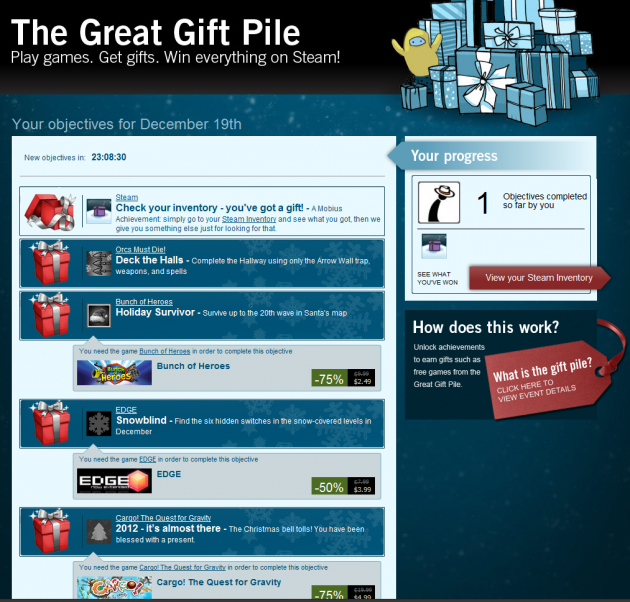There’s a lot of talk in the social media and marketing worlds about “gamification”. It’s one of those trendy buzzwords that experts and gurus are throwing around to try to increase their prestige and revenue. Meanwhile, a company who… well, makes and sells actual games for a living, has quietly rolled out the most textbook, brilliant example of gamification ever conceived.
I’m talking, of course, about Valve. Valve is a company who, quite simply, excels at marketing. They have created an absolute juggernaut of a sales engine for PC games in the form of Steam, and they have made it possible for Indie developers to reach audiences far larger than they ever could have reached on their own. They’ve made possible the “impulse buy” for PC games.
Today they launched their Holiday Sale, and it is one of the most well-conceived implementations of gamification ever presented.
Gamification at its finest
Here’s how it works:
Every Steam user (and there are millions) are notified: “Hey, there’s a Steam Holiday contest, with an amazing grand prize available!” The amazing grand prize is—and it is truly amazing—every single game that is available on the Steam library. This is thousands of video games. It’s worth a considerable sum of money. Remember that feeling that you got as a kid when you watched some lucky little snot on Nickelodeon win a ten minute Toys R Us shopping spree or something? Yeah, it’s kind of like that.
So, a nice big carrot is dangling out there. Oh, but there are smaller prizes to win, too. If you participate in any of the challenges (more on that soon), you get little virtual items: Maybe you get a gift, or maybe you get a lump of “coal”. To participate, all you have to do is complete objectives inside of video games. Easy, and fun!
Here’s where it gets scathingly brilliant. Right here:
There are six objectives to complete today. To maximize my chances of winning, I’m going to want to participate in all six.
The first challenge is super easy. Click a link (the link shows off a new feature of Steam they’re trying to advertise. Marketing objective one complete). Ding! I learn more about the new feature, and I very easily earned a chance to win.
The second challenge means I have to play a game called Orcs Must Die. I own the game, so I can complete the challenge. Marketing objective two complete. Valve can tell Robot Entertainment (their customer) that their game Orcs Must Die was featured in their contest. I’m going to take an educated guess here and say that Valve doesn’t offer this privilege for free. As I’m typing this, I see my little friends notification pop-up, showing me that friends of mine are playing Orcs Must Die. Suddenly everyone is interested in the game.
The third challenge requires a game that I don’t own—Bunch of Heroes. Oh, but look, there’s a little window below it, politely letting me know that all I need to do to complete that challenge is to buy Bunch of Heroes. Oh, and conveniently, it’s on sale today for 75% off. That’s a great deal! It’s only $2.49? That’s fantastic. I’ve never heard of this game in my life, but the urge to buy it (because it’s so cheap and because it offers me another ticket) is almost overwhelming. It seems dumb to not buy it. Marketing objective three? Nailed it. Selling non-premium products to consumers who normally wouldn’t have purchased it while making it seem as desirable as possible—it’s so devious it almost seems wrong (but yet so, so right).
And so it goes: You can see that there are two other games required for the challenges that I don’t own. If I didn’t have iron willpower (and a lack of liquid cash), you’d bet your ass I’d be buying all three of those games and playing them today to complete the challenge.
Oh, let’s not forget the last crowning touch: That little countdown timer at the top, relentlessly ticking down: You only have 24 hours to complete these objectives. Marketing objective four complete: a sense of urgency.
Ho Ho Ho
By wrapping all of this brilliance up with a nice holiday theme, Valve has not only created another timely sales juggernaut, they’ve also put the final finishing touch on their masterwork: Steam makes it very, very easy to gift people on your friends list with games. Many people will buy not only one copy of the $2.49 game they’ve never heard of… Since it’s 75% off TODAY ONLY, they may just buy an extra copy or two to give away to friends.
Some days I sit back and read marketing and social media blogs, Tweets, and Facebook posts. The ebb and flow is predictable and almost humorous (except that companies are still spending a great deal of money on this stuff, many times with negligible resutls). It goes like this: People in the industry scramble to learn the latest trends, write about how to implement them, and throw the buzzwords around. Others grasp on to the ‘thought leaders’, retweet it and blog about their own take on the trend. Then the naysayers come out and talk about how silly and useless it is, while offering their own take on how to properly do such-and-such for their clients. And so on. Gamification is one of those trends. Meanwhile, Valve, who makes no appearance on any of the marketing or social media blogs I’ve ever seen, is sitting here cranking out the Master’s Thesis… while also earning a lot of money for themselves and their publishers. They’re most likely laughing all the way to the bank.
















 Articles RSS
Articles RSS